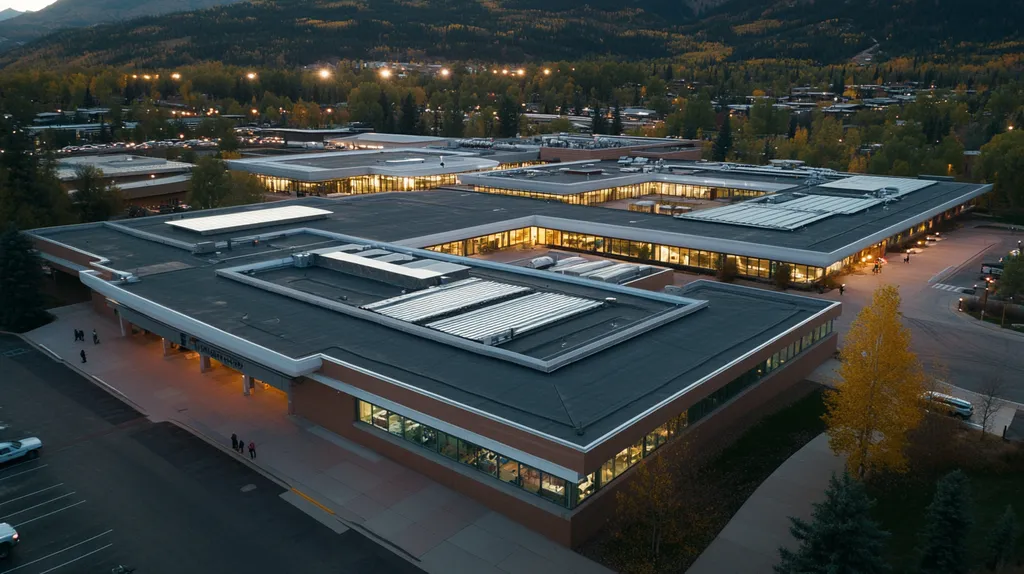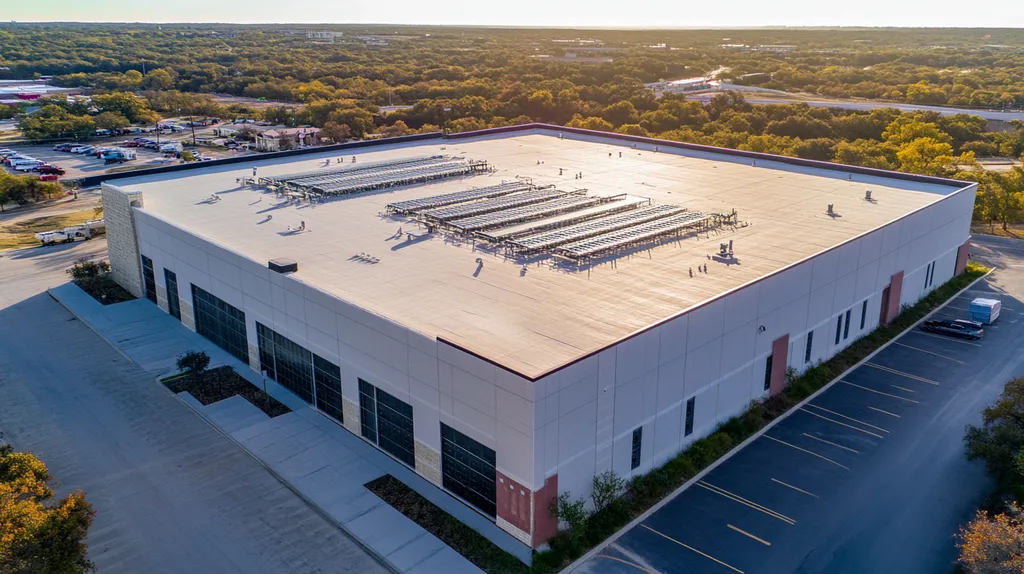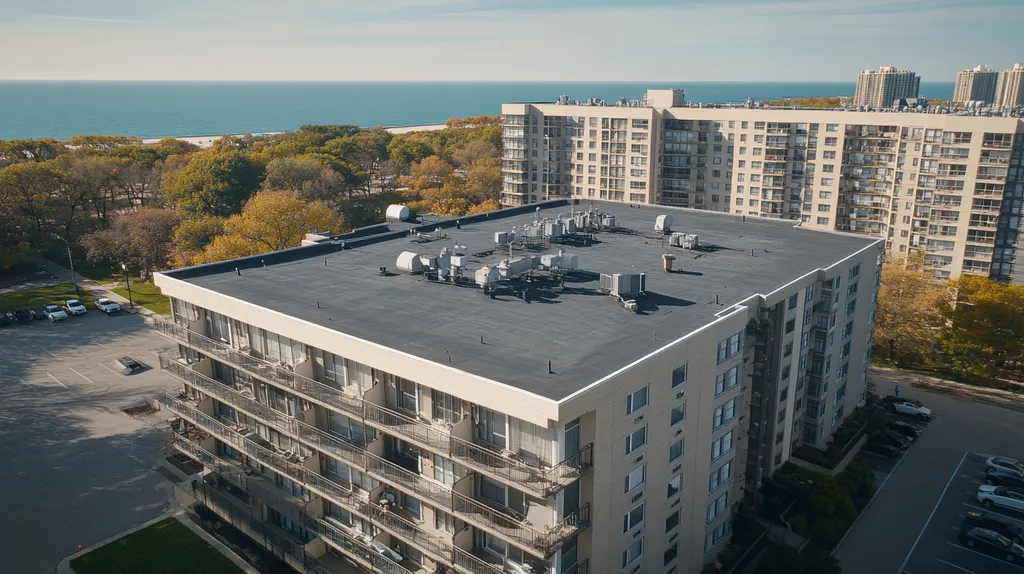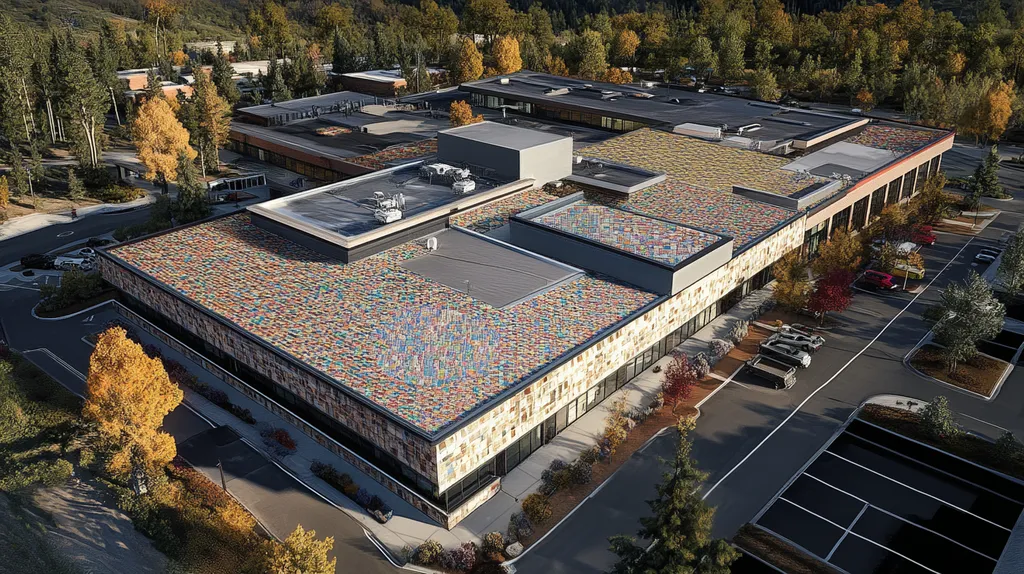In the industrial roofing sector, VOC regulations have transformed from simple guidelines to make-or-break compliance requirements that can halt entire projects. Recent EPA data shows that over 40% of industrial facilities struggle to meet current VOC standards, risking substantial fines and operational disruptions.
The evolution from traditional solvent-based coatings to modern low-VOC alternatives represents one of the most significant shifts in industrial roofing history. Understanding these changes has become essential for facility managers navigating an increasingly complex regulatory landscape.
This comprehensive guide examines VOC compliance from multiple angles: regulatory requirements, practical applications, and long-term performance implications. We’ll explore how modern solutions compare to historical approaches while providing actionable insights for today’s decision-makers.
SECTION 1: THE BASICS EXPLAINED
In the evolution of industrial roofing, few challenges have proven as persistent as managing Volatile Organic Compounds (VOCs). The days of unrestricted coating applications are long behind us, replaced by an era of stringent regulations and environmental consciousness. Today’s facility managers face a complex landscape where every coating decision must balance performance, compliance, and sustainability.
What It Is (In Plain Language)
VOCs represent chemicals that readily transform from liquids to gases at room temperature, much like the way a puddle evaporates on a warm day. These compounds have historically been essential components in roofing coatings, providing durability and weather resistance.
When we examine roofing materials from decades past, we find VOC levels that would be unthinkable by today’s standards. Modern regulations now restrict VOC content in industrial maintenance and roof coatings to specific grams per liter, fundamentally changing how these products are manufactured.
The U.S. Code of Federal Regulations specifically addresses VOC content through 40 CFR Part 59 Subpart D, establishing national standards that help control ozone formation. (source: United States Code of Federal Regulations)
Today’s coating technologies represent a dramatic departure from earlier formulations, offering high performance while meeting increasingly strict emission standards.
Why It Matters (To Your Building)
The stakes of VOC management extend far beyond mere regulatory compliance. Modern facility operations must consider the impact on indoor air quality, worker health, and environmental responsibility.
Looking back at buildings constructed before VOC awareness, we often find legacy issues that continue to affect air quality and maintenance costs. These historical examples serve as powerful reminders of why proper VOC management matters.
Financial implications have become increasingly significant as regulatory oversight intensifies. Non-compliance can result in substantial fines, while proactive VOC management often leads to long-term cost savings.
Buildings with well-managed VOC levels typically demonstrate better indoor air quality, reduced maintenance requirements, and higher occupant satisfaction rates.
How It Works
The process of managing VOCs begins with understanding their behavior throughout the coating’s lifecycle. From application to curing, these compounds interact differently with various environmental conditions and substrates.
Modern coating systems incorporate advanced technologies that would have seemed impossible just decades ago. These innovations allow for reduced VOC content while maintaining or even improving performance characteristics.
Proper application techniques play a crucial role in minimizing VOC impact. Temperature, humidity, and ventilation must all be carefully controlled during installation.
Success requires ongoing monitoring and documentation of VOC levels, ensuring compliance while maintaining the protective qualities essential for industrial roofing.
Regular assessments help identify potential issues before they become problems, allowing for proactive rather than reactive management strategies.
SECTION 2: PRACTICAL APPLICATIONS
In today’s industrial roofing landscape, understanding VOC compliance isn’t just about following regulations—it’s about protecting assets and people. Recent surveys indicate that improper VOC management affects nearly 40% of industrial facilities, leading to premature coating failures and increased maintenance costs. As regulations tighten and sustainability becomes paramount, facility managers must master the practical applications of VOC-compliant systems.
Common Uses & Examples
Industrial roofing applications commonly encounter VOC considerations in three critical areas: protective coatings, waterproofing membranes, and reflective finishes. Each serves distinct purposes while presenting unique compliance challenges.
Protective coatings represent the front line of roofing defense, with modern low-VOC formulations matching or exceeding the performance of their higher-emission predecessors. These advanced materials protect against UV damage, moisture intrusion, and chemical exposure.
Waterproofing systems have evolved from traditional solvent-based solutions to innovative water-based alternatives. These new technologies maintain excellent adhesion and flexibility while significantly reducing VOC emissions.
The Association for Materials Protection and Performance notes that industrial facilities emitting more than 100 tons of VOCs annually must obtain special permits or face substantial fines—up to $2,500 per ton. (source: AMPP)
When You Need It Most
VOC compliance becomes particularly critical during three key phases: initial installation, major repairs, and coating renewal cycles. These moments represent opportunities to implement better practices while avoiding costly mistakes.
Summer applications demand special attention, as higher temperatures accelerate VOC emissions. Proper timing and application techniques become essential for maintaining both compliance and coating performance.
Emergency repairs present unique challenges, requiring rapid response while maintaining VOC standards. Having pre-approved, compliant materials on hand helps prevent hasty decisions that could lead to violations.
Regular maintenance intervals offer planned opportunities to transition to lower-VOC alternatives. These systematic upgrades help facilities stay ahead of evolving regulations.
Interactions With Other Systems
Roofing coatings interact continuously with adjacent building systems, making VOC considerations crucial for overall facility performance. HVAC systems can distribute VOC emissions throughout the building if not properly managed.
Building envelope integrity depends heavily on coating compatibility. Low-VOC solutions must maintain proper adhesion with flashings, penetrations, and adjacent materials to ensure system longevity.
Energy management systems benefit from properly selected low-VOC coatings. Reflective properties and thermal resistance remain crucial performance factors, even as VOC content decreases.
Drainage systems require particular attention, as coating degradation can impact water flow patterns. Modern low-VOC solutions provide excellent weathering resistance while maintaining proper slope and drainage characteristics.
SECTION 3: KEY TERMINOLOGY DECODED
The language of VOC compliance has evolved dramatically since the early days of industrial roofing. What once consisted of simple product labels now encompasses a complex vocabulary of environmental terms, regulatory thresholds, and measurement standards. Today’s facility managers must navigate this technical terrain while making crucial decisions about roofing materials and application methods.
Essential Terms Explained
Volatile Organic Compounds represent more than just chemicals that evaporate – they embody a critical intersection of chemistry and environmental stewardship. Understanding their behavior helps inform better roofing decisions and ensures long-term protection for facilities.
The evolution of VOC terminology mirrors the industry’s growing environmental consciousness. Terms that once described simple material properties now carry significant regulatory and compliance implications.
Modern VOC terminology emphasizes both immediate and long-term impacts. This includes understanding flash points, cure times, and emission profiles throughout the coating’s lifecycle.
Recent regulations have introduced new terms related to exempt compounds and alternative solvents. These distinctions prove crucial when evaluating coating options and ensuring compliance across different jurisdictions.
Industry Jargon Translated
VOC regulations now cover a comprehensive range of roofing materials, including adhesives, sealants, primers, and coatings. This expanding scope requires facility managers to understand an increasingly complex vocabulary of compliance terms. (source: Firestone Building Products)
Terms like “solvent-borne” and “water-borne” that once simply described coating types now carry significant regulatory implications. Understanding these distinctions helps navigate compliance requirements while maintaining performance standards.
The industry has developed specialized terminology around cure times and application windows. These terms reflect both historical experience and modern environmental considerations.
Contemporary roofing vocabulary increasingly emphasizes sustainability metrics. Terms describing environmental impact have become as important as those describing physical properties.
Measurement & Units Simplified
The evolution of VOC measurement reflects decades of refinement in testing methods. Modern standards provide precise ways to quantify emissions and verify compliance.
Today’s measurement protocols address both initial VOC content and ongoing emissions. This dual focus helps ensure both immediate compliance and long-term performance.
Understanding the relationship between different measurement units proves essential. Converting between grams per liter, pounds per gallon, and other standards has become a crucial skill.
Historical measurement methods provide valuable context for modern standards. This perspective helps facility managers appreciate current compliance requirements while anticipating future changes.
SECTION 4: DECISION FACTORS
As industrial roofing evolves from the solvent-heavy coatings of decades past to today’s environmentally conscious solutions, decision-makers face increasingly complex choices. The transformation mirrors the industry’s journey from basic tar applications to sophisticated coating systems. While previous generations focused primarily on waterproofing performance, modern facility managers must navigate a matrix of VOC compliance, coating effectiveness, and financial implications.
Cost Considerations
Industrial maintenance coatings face strict VOC limits of 450 grams per liter, fundamentally affecting product selection and budget planning. Facilities emitting over 100 tons annually must secure specialized permits, adding another layer of financial consideration. (source: AMPP)
Looking back at historical coating practices reveals how dramatically material costs have shifted. While previous generations relied on basic asphaltic products, today’s advanced low-VOC formulations command premium prices that reflect their sophisticated chemistry.
Installation expenses often increase with low-VOC products due to specialized application requirements and longer cure times. However, these initial investments typically offset potential regulatory fines and environmental impact costs.
Many facilities find that proper budgeting for compliant coatings prevents costly remediation projects later. Strategic planning should account for both immediate application costs and long-term maintenance requirements.
Performance Trade-offs
The evolution from traditional high-VOC coatings to modern compliant solutions has transformed performance expectations. Where past generations measured success purely by water resistance, today’s coatings must deliver multiple performance attributes while maintaining environmental standards.
Application windows have changed significantly with modern formulations. Low-VOC coatings often require more precise temperature and humidity controls, reminiscent of the careful timing needed for early cold-process systems.
Chemical resistance profiles differ between traditional and compliant coatings. While some newer formulations match their predecessors’ durability, others may require additional maintenance to achieve similar protection levels.
Weather resistance capabilities continue evolving as manufacturers refine their technologies. Modern coatings increasingly match or exceed the performance of historical high-VOC products, though achieving these results often requires strict adherence to application specifications.
Lifespan & Durability Factors
Today’s coating lifespans reflect decades of formulation refinement. Where early environmentally conscious products sometimes sacrificed longevity for compliance, modern solutions increasingly deliver both durability and sustainability.
Climate considerations remain as crucial now as they were in the era of traditional coatings. Regional weather patterns, UV exposure, and temperature fluctuations continue influencing coating selection and expected service life.
Maintenance requirements have evolved alongside coating technologies. While some low-VOC systems demand more frequent inspections than their predecessors, they often provide better indicators of potential failure points.
Long-term performance data increasingly demonstrates that properly selected and applied compliant coatings can match or exceed traditional systems’ durability. This evolution mirrors the industry’s broader transition from reactive maintenance to proactive asset management.
SECTION 5: COMMON CHALLENGES
The evolution of VOC compliance in industrial roofing mirrors the industry’s broader journey from basic waterproofing to sophisticated environmental stewardship. Where past generations struggled with basic coating adhesion, today’s facility managers face an intricate web of regulatory requirements, material limitations, and performance demands. Understanding these challenges through the lens of historical experience helps illuminate the path forward while avoiding costly missteps.
Frequent Problems & Solutions
The U.S. Environmental Protection Agency’s Architectural Coating Rule has transformed how we approach industrial roofing, establishing strict VOC content limits and labeling requirements that fundamentally change material selection and application processes. (source: U.S. Environmental Protection Agency)
Weather conditions during application present persistent challenges that echo the difficulties faced with traditional hot-applied systems. Temperature fluctuations and humidity levels can dramatically affect VOC emissions, requiring careful timing and monitoring throughout the installation process.
Material compatibility issues frequently arise when transitioning from older high-VOC systems to modern compliant coatings. Proper surface preparation and primer selection become critical factors in achieving lasting adhesion.
Storage and handling requirements have evolved significantly, demanding sophisticated inventory management systems. Temperature-controlled storage areas and proper ventilation help maintain coating integrity while minimizing unwanted emissions.
Warning Signs To Watch For
Early detection of coating failures has become increasingly sophisticated since the days of simple visual inspections. Modern assessment techniques combine traditional observation with advanced monitoring systems to identify potential issues before they escalate.
Surface irregularities that once might have been dismissed as cosmetic now serve as crucial indicators of VOC-related problems. Blistering, crazing, and premature erosion often signal underlying compliance issues.
Changes in coating flexibility and adhesion properties may indicate VOC-related degradation. Regular pull tests and elongation measurements help track these changes over time.
Indoor air quality measurements provide early warning of potential VOC issues. Contemporary monitoring systems can detect subtle changes that would have gone unnoticed in previous decades.
Preventative Approaches
Modern preventative strategies draw upon lessons learned from decades of coating evolution. Comprehensive maintenance programs now incorporate VOC monitoring alongside traditional inspection protocols.
Documentation requirements have expanded dramatically from the simple application records of the past. Today’s compliance tracking demands detailed emissions monitoring and regular reporting.
Training programs have evolved to emphasize both technical proficiency and environmental awareness. Applicator certification now includes specific modules on VOC management and compliance verification.
Quality control measures reflect the industry’s transformation from reactive to proactive approaches. Regular material testing and environmental monitoring help prevent compliance issues before they develop.
SECTION 6: NEXT STEPS & RESOURCES
The evolution of VOC management in industrial roofing reflects a dramatic shift from the simplicity of past decades to today’s complex regulatory landscape. Where facility managers once focused primarily on waterproofing performance, modern operations demand sophisticated understanding of environmental compliance, health impacts, and sustainable practices. This transformation requires new approaches to provider selection, standards adherence, and ongoing education.
Questions To Ask Providers
The Association for Materials Protection and Performance emphasizes that project managers must thoroughly understand VOC regulations and control methods, with industrial maintenance coatings limited to 450 grams per liter. Facilities emitting over 100 tons annually face additional permitting requirements and reporting obligations. (source: AMPP)
Provider evaluations must extend beyond traditional performance metrics to include detailed VOC management protocols. Request documentation of their experience with low-VOC installations and their strategies for maintaining compliance throughout application.
Historical coating practices offer valuable context for modern provider assessment. Understanding how contractors have adapted from traditional high-VOC methods to contemporary solutions reveals their commitment to environmental stewardship.
Quality control procedures deserve particular scrutiny, as proper VOC management requires sophisticated monitoring and documentation. Ask about specific measures for controlling emissions during application and curing phases.
Industry Standards & Guidelines
Today’s standards represent decades of evolution from basic material specifications to comprehensive environmental protocols. Understanding these requirements helps facilities anticipate compliance needs while maintaining coating performance.
Regional variations in VOC regulations continue influencing coating selection and application methods. Facilities must consider both national standards and local requirements when planning roofing projects.
Documentation requirements have expanded significantly from the simple material certifications of past decades. Modern standards demand detailed tracking of VOC emissions throughout the coating’s lifecycle.
Testing protocols reflect the industry’s growing emphasis on environmental impact. Contemporary standards incorporate sophisticated methods for measuring both initial VOC content and ongoing emissions.
Further Learning Simplified
The transformation from traditional coating practices to modern VOC management demands ongoing education. Understanding this evolution helps facilities anticipate future trends while maintaining current compliance.
Professional development opportunities have expanded beyond basic application techniques to include environmental management principles. These resources help bridge the gap between historical practices and contemporary requirements.
Industry associations provide valuable historical perspective alongside current best practices. Their resources document the evolution of VOC management while highlighting emerging technologies.
Technical publications increasingly emphasize the connection between past experiences and modern solutions. This context helps facilities avoid repeating historical mistakes while implementing contemporary best practices.
Looking Ahead
The industrial roofing sector stands at a critical junction where VOC compliance can mean the difference between operational success and devastating regulatory penalties.
With over 40% of facilities currently struggling to meet VOC standards, the stakes have never been higher for property managers and building owners.
The transition from traditional high-VOC coatings to modern compliant solutions represents more than regulatory compliance—it reflects an industry-wide evolution toward sustainable building practices.
As regulations continue to tighten and enforcement intensifies, facilities must embrace comprehensive VOC management strategies or risk substantial fines and operational disruptions.
The future of industrial roofing lies not just in meeting current standards, but in anticipating and adapting to increasingly stringent environmental requirements that will shape the industry for decades to come.
FREQUENTLY ASKED QUESTIONS
Q. What are VOC levels in commercial roofing?
A. VOC levels refer to the concentration of volatile organic compounds in roofing coatings. These compounds evaporate easily and can significantly impact indoor air quality and environmental compliance. Understanding and managing these levels is essential for achieving regulatory compliance and fostering a healthier environment.
Q. How do you ensure VOC compliance for an industrial roof?
A. To ensure VOC compliance, choose roofing materials that meet the specified limits for volatile organic compounds. Regularly monitor VOC emissions throughout the lifecycle of the materials and maintain documentation to verify compliance with regulations, thus avoiding potential fines and contributing to sustainability efforts.
Q. What are common VOC compliance challenges for industrial roofs?
A. Common challenges include adapting to new regulatory requirements and selecting compliant products. Additionally, environmental conditions during application can complicate compliance, as temperature and humidity can influence VOC emissions. Understanding these factors is crucial for effective management.
Q. How can you minimize VOC emissions during installation?
A. To minimize VOC emissions, carefully control installation conditions such as temperature and humidity. Opt for low-VOC products and plan application during cooler times of the day. Additionally, proper ventilation is essential to help disperse any emitted VOCs, protecting both workers and the environment.
Q. What does VOC stand for in industrial roofing?
A. VOC stands for volatile organic compounds, which are chemicals found in many industrial roofing materials. These compounds can evaporate into the air, contributing to air pollution and impacting indoor air quality. Understanding and managing VOC levels has become critical for compliance and overall environmental health.
Q. Are there specific regulations for VOC levels in roofing?
A. Yes, regulations surrounding VOC levels vary by region and are defined to control air quality. The U.S. Environmental Protection Agency’s Architectural Coating Rule sets limits on VOC content for various coatings used in commercial and industrial roofing applications. Compliance with these regulations is essential to avoid fines.
Q. What should I ask roofing providers about VOC management?
A. Inquire about their experience with low-VOC products and installation practices. Ask how they ensure compliance with regulations and what quality control measures they utilize during application. Understanding their approach to managing VOC emissions will help you assess their commitment to sustainability and regulatory adherence.











